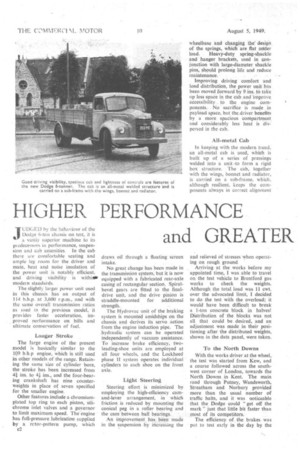DAVID BROWN SERVICE MANUAL
Page 37

Page 38

Page 39

If you've noticed an error in this article please click here to report it so we can fix it.
THE recently published service manual dealing with the David Brown tractor reaches a high standard in literature of this kind. It is split up into 14 sections, reference to any section being by a thumb index, which is printed on stout card separating the. sections, The text pages, which include a large. number of line drawings and half-tone illnstrations, are printed on semi-art paper, which makes for partictilarly good reproduction of the half-tones. Of the loose-leaf type, the manual can always be kept up to date, as and_when modifications are effected in the machine.
Users of David Brown tractors not already in possession of a copy should write to David Brown Tractors, Ltd., Islettham, Yorkshire.
wheelbase and changing the: design of the springs, which are fiat under load. • Heavy-duty spring-shackle and hanger brackets, used in conjunction with large-diameter shackle pins, should prolong life and reduce maintenance. •
Improving driving • comfort and load distribution, the power unit has been moved forward by 9 ins, to take up less space in the cab ancrimprove accessibility., to the engine components. No sacrifice is made in payload space, but the.driver .benefits by a more spacious 'compartment and considerably less heat is dispersed in the cab.
All-metal Cub
In keeping with the modern trend, an all-metal cab is used, which is built up of a series of pressings welded into a unit ,to form a rigid box structure. The cab, together with the wings, bonnet and radiator, is carried on a sub-frame, which, although resilient, keeps the components always in correct alignment
unpredicted behaviour of a pedestrian, and the Dodge responded to an emergency application of the pedal, as though it were hooked to an arrester wire.
East Hill, Wandsworth, was climbed from a standing start in third gear—a creditable performance for an overladen 6-tormer. The engine .flexibility was again demonstrated when travelling up the slope by Croydon Airport, and top gear was used right to the top of the incline.
The climax came when attempting the 700-yd. Succombs Hill, which that it did not falter under such a severe test, and that the climb was made in under three minutes. There was a 20-degree rise in water temperature by the time the summit of the hill was reached.
Then followed a swift run through Warlinghann and Chelsham, with a test for brake fade upon descending Westerharn Hill. With top gear engaged and using the brakes to restrict the speed to 25 M.p.h., there was a slight loss in efficiency by the time the foot of the hill was reached, but the pedal still had a fair amount of travel before reaching the floorboards.
























































































